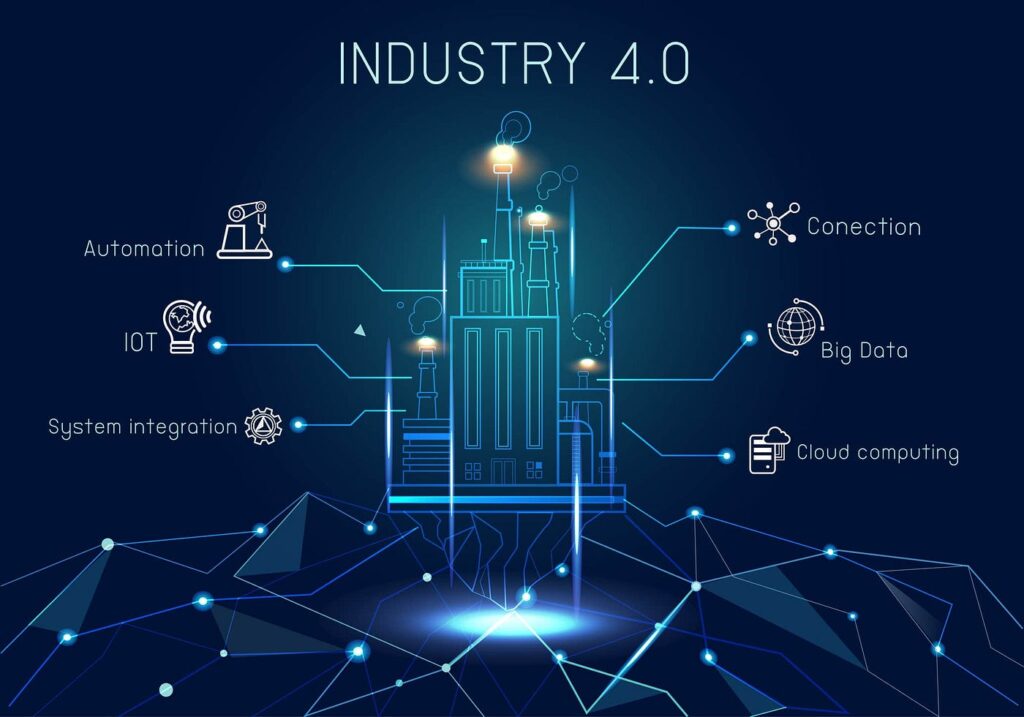Learn how 4.0 technologies are revolutionizing product manufacturing

The landscape of manufacturing has been constantly evolving throughout history, driven by innovation and the pursuit of efficiency. However, in recent years, a profound transformation has been underway that promises to revolutionize the industry further. We’re now in the era of Industry 4.0, a term that encompasses a suite of cutting-edge technologies and practices that are reshaping how we manufacture goods. In this blog post, we’ll explore the evolution of manufacturing processes and how Industry 4.0 is changing the game.
The Industrial Revolution and the Birth of Mass Production.
The journey of manufacturing evolution dates back to the late 18th century with the advent of the first Industrial Revolution. This era saw the transition from agrarian and craft-based economies to mechanized and factory-driven ones. The introduction of water and steam power, mechanization of textile production, and innovations like the cotton gin ushered in an era of mass production.
The Second Industrial Revolution and Assembly Lines
Automation and Computerization
The latter half of the 20th century brought automation and computerization to manufacturing processes. Robots began to take on repetitive and dangerous tasks in factories, improving safety and precision. Computer-aided design (CAD) and computer-aided manufacturing (CAM) systems allowed for more precise product design and manufacturing.
The Emergence of Industry 4.0
Now, as we move further into the 21st century, we find ourselves at the dawn of Industry 4.0. This new industrial era is defined by the convergence of digital technologies, the Internet of Things (IoT), big data, artificial intelligence (AI), and automation. Here’s how these elements are transforming manufacturing:
1.Smart Factories:
Industry 4.0 introduces the concept of smart factories, where machines and systems communicate with each other autonomously. Sensors placed throughout the production line collect data, which is then analyzed by AI algorithms. This real-time data analysis allows for predictive maintenance, reducing downtime and improving overall efficiency.
2.Automation and Robotics:
Automation has reached new heights with Industry 4.0. Robots and autonomous machines are now more versatile and capable than ever before. They can handle intricate tasks with precision, collaborate with human workers, and adapt to changing production needs quickly.
3.Internet of Things (IoT):
The IoT connects machines, devices, and systems, enabling seamless data sharing and remote monitoring. Manufacturers can track the performance of equipment, monitor energy usage, and optimize processes in real time. This connectivity also facilitates inventory management and supply chain optimization.
4.Big Data and Analytics:
The vast amount of data generated by smart factories can be harnessed through big data analytics. Manufacturers can gain valuable insights into production processes, identify bottlenecks, and make data-driven decisions to enhance productivity and product quality.
5.Digital Twins:
Digital twins are virtual replicas of physical products or processes. By creating digital twins, manufacturers can simulate and analyze production scenarios before implementing changes in the real world. This reduces the risk of errors and accelerates innovation.
6.Customization and Personalization:
Industry 4.0 technologies enable greater customization and personalization of products. Mass production is no longer limited to uniform goods; instead, manufacturers can efficiently produce tailored products that meet individual customer preferences.
7.Sustainability and Efficiency:
Through data-driven insights and optimization, Industry 4.0 contributes to sustainability efforts by reducing waste, energy consumption, and environmental impact. Efficient use of resources is a hallmark of this new era.
Challenges and Opportunities
While Industry 4.0 offers incredible potential, it also presents challenges. The integration of these technologies requires significant investments in infrastructure and employee training. There are concerns about cybersecurity as more systems become connected. Additionally, the potential displacement of jobs due to automation is a valid concern that needs to be addressed.
However, the opportunities for manufacturers embracing Industry 4.0 are vast. Greater efficiency, improved quality, reduced operational costs, and enhanced competitiveness on a global scale are all within reach. The ability to respond swiftly to market changes and customer demands is a significant advantage.
In conclusion, the evolution of manufacturing processes has been a remarkable journey, from the first factories of the Industrial Revolution to the smart factories of Industry 4.0. Embracing Industry 4.0 means harnessing the power of digital transformation, IoT, automation, and data analytics to revolutionize how products are made. While challenges exist, the potential for increased efficiency, sustainability, customization, and competitiveness is driving manufacturers to adapt and thrive in this exciting new era of Industry 4.0. Those who do will undoubtedly shape the future of manufacturing.

Ready to Plan For Your Successful Launch?
For A Diagnostic Evaluation For Your Project Success.
What makes a product a success

